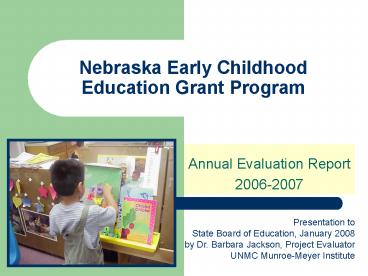Nebraska Early Childhood Education Grant Program - PowerPoint PPT Presentation
1 / 30
Title:
Nebraska Early Childhood Education Grant Program
Description:
... experiences for young children experienced academic success as reflected in the ... University of Nebraska Medical Center. Munroe-Meyer Institute ... – PowerPoint PPT presentation
Number of Views:40
Avg rating:3.0/5.0
Title: Nebraska Early Childhood Education Grant Program
1
Nebraska Early Childhood Education Grant Program
- Annual Evaluation Report
- 2006-2007
Presentation to State Board of Education, January
2008 by Dr. Barbara Jackson, Project Evaluator
UNMC Munroe-Meyer Institute
2
What is the purpose?
- provide high quality early childhood education
program experiences - assist children to reach their full potential and
increase the likelihood of their later success in
school
3
Program Model
- Targeted Age Group
- 92 served 3- and 4-year-old children
- Classroom Size
- 16 to 20 children
- Classroom programming for
- Part day (less than 6 hours)
- n64 classrooms
- Full day (6 hours or more)
- n23 classroom
4
Who is eligible?
- whose family income qualified them for
participation in the federal free or reduced
lunch program, - who reside in a home where a language other than
English is used as the primary means of
communication, - who were born prematurely or at low birth weight,
or - whose parents were younger than eighteen or who
had not completed high school.
5
1,618 Children Served in 38 School Districts or
ESUs
6
Total Budget (33 grant funds and 67 match)
11,144,230
- Largest of Funding
- Nebraska ECE Grant Program (33),
- Local district funds (16),
- Special education funds (14), and
- Head Start (15).
7
What is the quality of the early childhood
education programs?
Early Childhood Environmental Rating Scales ECERS
- 100 of the preschool programs met state
indicator of quality regarding criteria on the
ECERS - Received an overall rating of 5 or higher of
7 maximum
8
What is the quality of the early childhood
education programs?
Early Language and Literacy Classroom
Observation ELLCO
- 90 of the preschool programs met state indicator
of quality regarding criteria on the ELLCO - Technical assistance was provided for those
programs not meeting criteria. - Received an overall score of 67 or higher
9
NAEYC Accreditation
- 15 programs are accredited
10
Evaluation of Short-Term Outcomes Results
Matter Assessment Choices
- High/Scope Child Observation Record (COR)
- Creative Curriculum Developmental Continuum
(CCDC) - Assessment, Evaluation, and Programming System
(AEPS)
11
What are the short-term benefits for the
preschool children? High/Scope COR
Summary of Preschool Findings across by Age
Group COR
24 programs
12
What are the short-term benefits for the
preschool children? Creative Curriculum
Developmental Continuum (CCDC)
Summary of Preschool Findings across by Age
Group CCDC
12 programs
13
The results across both the High/Scope COR and
CCDC indicated that
- Preschoolers across ages made substantial gains
across all areas - Girls scored slightly higher than boys in all
areas and showed larger gain scores. - By end of the year, the 4 year-old children who
were ELL made greater gains to the extent they
scored slightly higher than their English
speaking peers in math/cognitive.
14
Results Matter Analysis
n308
15
Results Matter Analysis
n308
16
Summary of Results Matter Analysis
- By spring, 95 of the children were scoring at
the 40th percentile ---a 20 increase from the
fall. - The majority of the children made greater than
expected gains (change in percentile rank
groupings) - A larger percentage of girls were at or above the
40th percentile at the end of the year.
17
The ECE grant programmade a substantial impact
on the children served.
18
Long Term Results
- Sixty-seven (67) percent of the children in ECE
grant programs were eligible for free and reduced
lunch, compared to the state percent of 36. - The number of children receiving special
education services was a similar percentage
across both groups.
19
Long Term Outcomes Standardized Assessment
Summary of Percentage of Children Scoring Above
the National Average in READING
14 programs 228 children
20
Long Term Outcomes Standardized Assessment
A Comparison of Students with ECE Grant
Experience with State Averages
Summary of Percentage of Children Scoring Above
the National Average in MATH
21
The majority of ECE grant children scored above
the national average on achievement tests in
reading and math.
22
Nebraska Student-Based, Teacher-Led Assessment
and Reporting System (STARS) Outcomes
Summary of Percentage of Children that Met or
Exceeded Standards in READING
4 Programs 134 Children
23
Nebraska Student-Based, Teacher-Led Assessment
and Reporting System (STARS) Outcomes
Summary of Percentage of Children that Met or
Exceeded Standards in MATH
24
Nebraska Student-Based, Teacher-Led Assessment
and Reporting System (STARS) Outcomes
Summary of Percentage of Children that Met or
Exceeded Standards in WRITING
25
ECE Grant Children are Succeeding in School
- The majority (84-89)of ECE grant children Met or
Exceeded State Standards in Math, Reading and
Writing - ECE grant children generally performed on par
with their peers, even though they represented a
higher percentage of children eligible for free
or reduced lunch.
26
Conclusions
- ECE Grant programs are of high quality
27
ECE Grant Program made a difference
- Participation in high quality experiences for
young children resulted in immediate short-term
benefits as reflected in - significant gains in development and learning
outcomes - many children making greater than expected
progress.
28
ECE Grant Program made a difference
- Participation in high quality experiences for
young children experienced academic success as
reflected in the majority of ECE children - performing in the 50th percentile or greater on
achievement tests. - meeting or exceeding district standards in
reading, writing and math.
29
Questions?
30
Early Childhood Education Grant
ProgramEvaluation Report Executive Summary and
Full Reportavailable online at
www.nde.state.ne.us/ECH/ECH.html
- Project Evaluators
- Dr. Barbara Jackson Dr. Lisa St. Clair
- University of Nebraska Medical Center
- Munroe-Meyer Institute































